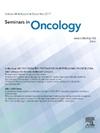Atezolizumab联合贝伐单抗与Lenvatinib治疗巴塞罗那临床肝癌B期(BCLC-B)肝细胞癌(HCC)患者:现实世界人群
IF 2.5
3区 医学
Q2 ONCOLOGY
引用次数: 0
摘要
本研究的目的是对巴塞罗那临床肝癌B期(BCLC-B)肝细胞癌(HCC)的大型患者队列进行现实世界的分析,这些患者接受atezolizumab加贝伐单抗(a + B)或Lenvatinib治疗。方法研究人群包括来自东西方人群的不适合局部治疗(LRTs)的巴塞罗那临床肝癌B期(BCLC-B)肝细胞癌患者,他们接受atezolizumab联合贝伐单抗(A + B)或Lenvatinib作为一线治疗。采用单因素和多因素分析评估总生存期(OS)和进展时间(TTP)的预测因素,采用Cox回归模型对预后因素进行单因素和多因素分析。结果本研究共纳入919例BCLC-B型HCC患者。561例(61%)患者服用Lenvatinib, 358例(39%)患者服用A + B。接受Lenvatinib的患者的中位总生存期(mOS)为21.3个月,而一线治疗A + B (Lenvatinib vs A + B)的患者为15.8个月,风险比(hr) 0.84 P = 0.22。接受Lenvatinib的患者的中位进展时间(mTTP)为7.3个月,而一线治疗接受A + B (Lenvatinib vs A + B)的患者为8.7个月:HR 1.15 P = 0.10。多变量分析证实两种治疗在mOS和mTTP方面没有差异。Lenvatinib组患者的客观缓解率(ORR)为47.1%,A + B P <; 0.000001组患者为27.1%。与接受a + B的患者相比,接受Lenvatinib的患者发生手足皮肤反应(HFSR)、高血压、腹泻、疲劳、食欲下降、甲状腺功能减退和其他毒性反应的发生率明显更高。Lenvatinib组OS的有利预后因素为血小板(PLT) > 100,000 (HR 0.68 P = 0.02),HCC非酒精性脂肪性肝炎/非酒精性脂肪性肝病(NASH/NAFLD)相关(HR 0.53, P = 0.03)。A组 + B组未发现预后有利因素。A + B组TTP的有利预后因素为TACE难治性患者(HR 0.76, P = 0.02),PLT <;10万(HR 0.62, P = 0.0067),中性粒细胞与淋巴细胞比值(NLR) <;3 (hr 0.78, p = 0.04)。结论虽然Lenvatinib的有效率更高,但研究显示Lenvatinib与a + B在BCLC-B HCC患者的疗效方面无统计学差异。本文章由计算机程序翻译,如有差异,请以英文原文为准。
Atezolizumab plus bevacizumab versus Lenvatinib for patients with Barcelona clinic liver cancer stage B (BCLC-B) hepatocellular carcinoma (HCC): A real-world population
Background
The aim of the present study was to perform a real-world analysis on a large patient cohort with Barcelona Clinic Liver Cancer stage B (BCLC-B) hepatocellular carcinoma (HCC) treated with atezolizumab plus bevacizumab (A + B) or with Lenvatinib.
Methods
The study population included patients affected with Barcelona Clinic Liver Cancer stage B (BCLC-B) hepatocellular carcinoma not suitable for locoregional therapies (LRTs) from eastern and western populations, who received atezolizumab plus bevacizumab (A + B) or Lenvatinib as first-line treatment. Univariate and multivariate analyses were used to evaluate predictive factors for overall survival (OS) and time to progression (TTP) while prognostic factors were analyzed by univariate and multivariate analysis using Cox regression model.
Results
919 patients with BCLC-B HCC were analyzed in the study. Lenvatinib was administered to 561 (61%) patients while 358 (39%) received A + B. The median overall survival (mOS) for patients receiving Lenvatinib was 21.3 months compared to 15.8 months for patients receiving A + B as first-line treatment (Lenvatinib v A + B), hazard ratio (HRs) 0.84 P = 0.22. The median time to progression (mTTP) for patients receiving Lenvatinib was 7.3 months compared to 8.7 months for patients receiving A + B as first-line treatment (Lenvatinib v A + B): HR 1.15 P = 0.10. Multivariate analysis confirmed no different in terms of mOS and mTTP between the two treatments. Objective response rate (ORR) was 47.1% for patients receiving Lenvatinib and 27.1% for patients receiving A + B P < 0.000001. Patients receiving Lenvatinib experienced a significantly higher incidence of hand-foot skin reaction (HFSR), hypertension, diarrhea, fatigue, decrease appetite, hypothyroidism, and other toxicity compared to patients receiving A + B. Favorable prognostic factors for OS in Lenvatinib group were platelets (PLT) >100.000 (HR 0.68 P = 0.02), HCC nonalcoholic steatohepatitis/nonalcoholic fatty liver disease (NASH/NAFLD) related (HR 0.53, P = 0.03). No favorable prognostic factors were found for A + B group. Favorable prognostic factors for TTP in the A + B group were in TACE refractory patients (HR 0.76, P = 0.02), PLT <100.000 (HR 0.62, P = 0.0067), and neutrophil-to-lymphocyte ratio (NLR) < 3 (HR 0.78, P = 0.04).
Conclusion
Although Lenvatinib had a higher response rate, the study showed no statistically significant differences between Lenvatinib and A + B in terms of efficacy, in patients with BCLC-B HCC.
求助全文
通过发布文献求助,成功后即可免费获取论文全文。
去求助
来源期刊

Seminars in oncology
医学-肿瘤学
CiteScore
6.60
自引率
0.00%
发文量
58
审稿时长
104 days
期刊介绍:
Seminars in Oncology brings you current, authoritative, and practical reviews of developments in the etiology, diagnosis and management of cancer. Each issue examines topics of clinical importance, with an emphasis on providing both the basic knowledge needed to better understand a topic as well as evidence-based opinions from leaders in the field. Seminars in Oncology also seeks to be a venue for sharing a diversity of opinions including those that might be considered "outside the box". We welcome a healthy and respectful exchange of opinions and urge you to approach us with your insights as well as suggestions of topics that you deem worthy of coverage. By helping the reader understand the basic biology and the therapy of cancer as they learn the nuances from experts, all in a journal that encourages the exchange of ideas we aim to help move the treatment of cancer forward.
 求助内容:
求助内容: 应助结果提醒方式:
应助结果提醒方式:


